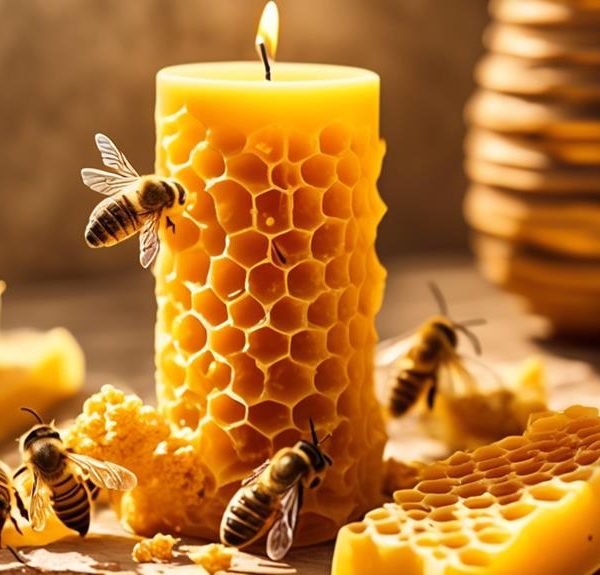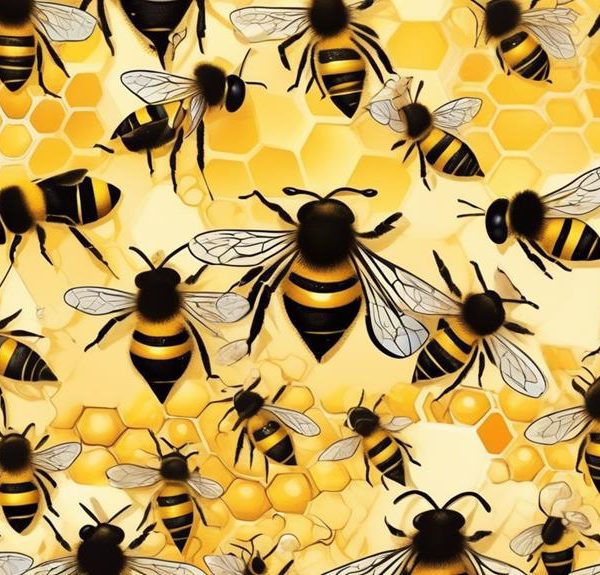Wondering what beeswax is made of? Dive into the intricate process involving honey-diet worker bees and discover its versatility and value.
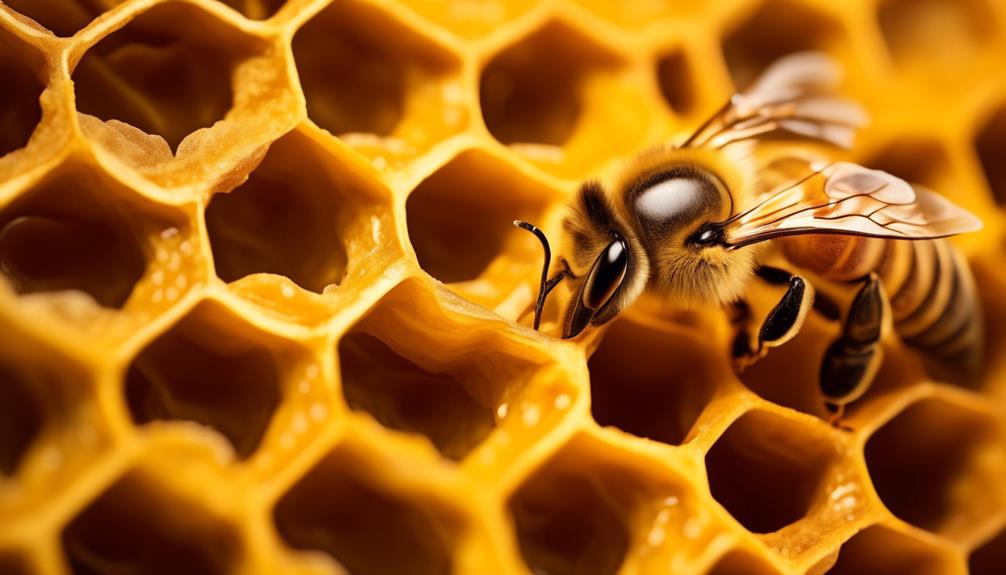
What Is Beeswax Made Out Of?
Have you ever wondered what beeswax is made of? It's not just a simple substance that bees magically produce. Actually, beeswax is the result of a fascinating process that involves worker bees, their special glands, and a diet of honey.
This complex substance, composed of over 300 compounds, has wide-ranging uses that extend far beyond the hive. But how exactly is it made, and what makes it so versatile and valuable?
Let's uncover the intricate story of beeswax, drawing you in to unravel its mysteries in more detail.
Key Takeaways
- Beeswax is a natural wax produced by honey bees in their beehives.
- It is mainly composed of esters, fatty acids, long-chain alcohols, hydrocarbons, trace elements, pollen, and propolis.
- Beeswax has various uses and benefits, such as in cosmetics, candles, cheese coating, and sustainable food wraps.
- Beeswax production is sustainable and relies on bee-friendly practices and pesticide-free beekeeping operations.
The Basics of Beeswax
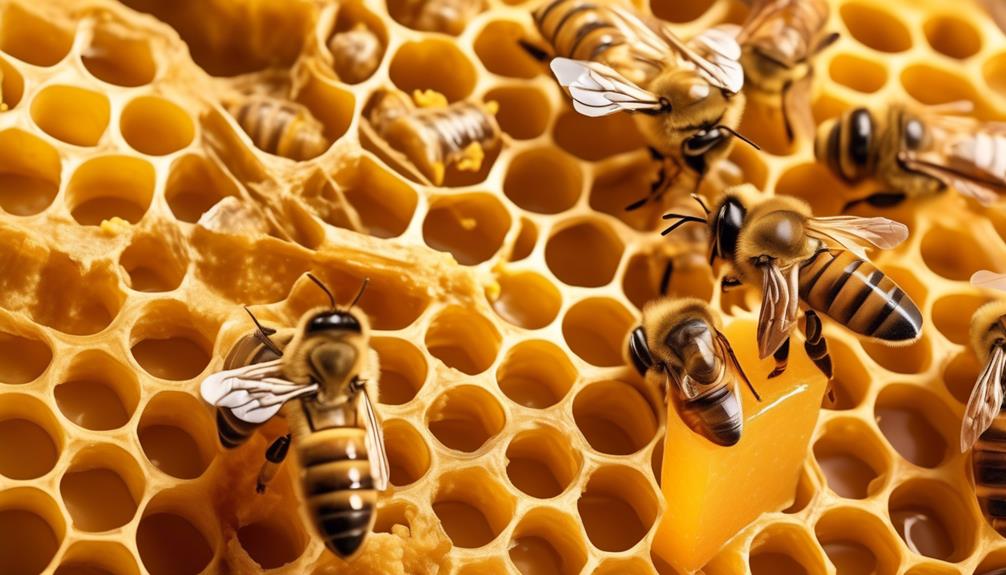
Diving into the basics of beeswax, you'll find that it's a natural wax produced by honey bees, specifically those of the genus Apis, in their beehives. Beeswax is a byproduct of honey-making, secreted by worker bees from glands on the sides of their bodies. They use it to build the hexagonal cells of their honeycomb where honey is stored and larvae are nurtured.
The composition of beeswax is complex, primarily consisting of esters, hydrocarbons, and free fatty acids. It might interest you to know that the color of beeswax varies from nearly white to brownish, depending on purity, the type of flowers the bees visit, and the age of the wax.
Freshly produced beeswax is glass-clear and colorless. It becomes opaque after mastication and adulteration with pollen by the hive worker bees. The wax's aroma, often described as 'honey-like', is derived from the pollen and propolis, or bee glue, in the hive.
Beeswax's properties – its pliability, water resistance, and capacity to hold form – make it invaluable in various industries: from cosmetics and pharmaceuticals to art and food. Understanding beeswax's basics gives you a glimpse into the fascinating world of bees and their industrious nature.
How Bees Produce Beeswax
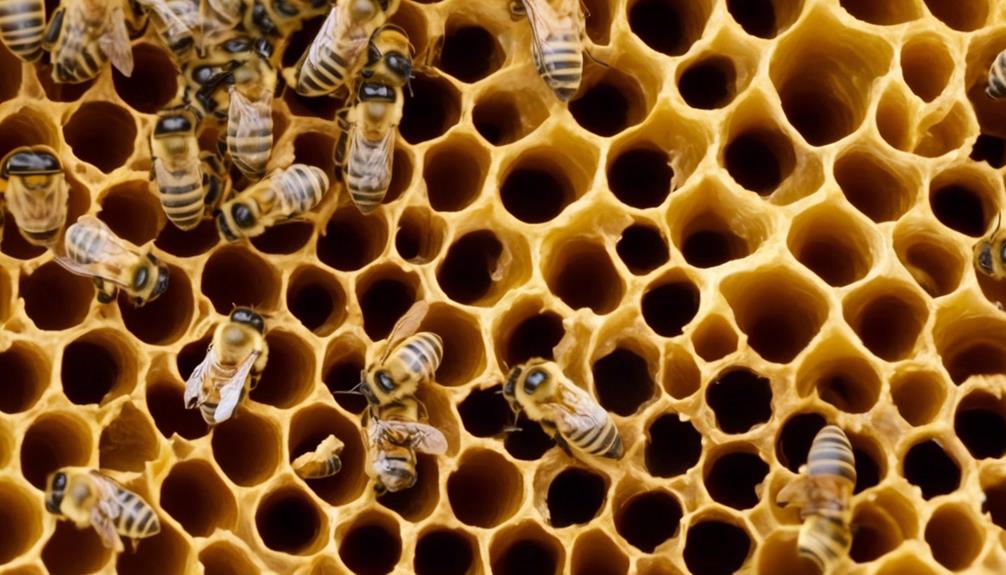
Having grasped the basics of beeswax, let's now explore how bees actually produce this versatile substance. You might be surprised to learn that this process is a fascinating example of nature's ingenuity.
Young worker bees, specifically those between 12 and 20 days old, are the ones tasked with the production of beeswax. It's during these prime days of their short lives that eight wax-producing glands located on the underside of their abdomen are most active. These glands convert the bee's sugar intake into wax, which oozes out through small pores in their body and hardens upon contact with air.
This wax appears as small, transparent flakes on the bee's abdomen. The bees then chew these flakes, mixing them with saliva which adds enzymes and transforms the wax into a malleable substance. It's this pliable wax that worker bees shape into the hexagonal cells that make up the honeycomb.
Now, you're probably wondering why they choose a hexagonal shape. Well, it's because this design allows for the most efficient use of space and materials. It's a perfect example of how nature often opts for the most economical solutions. Isn't that fascinating?
The Components of Beeswax
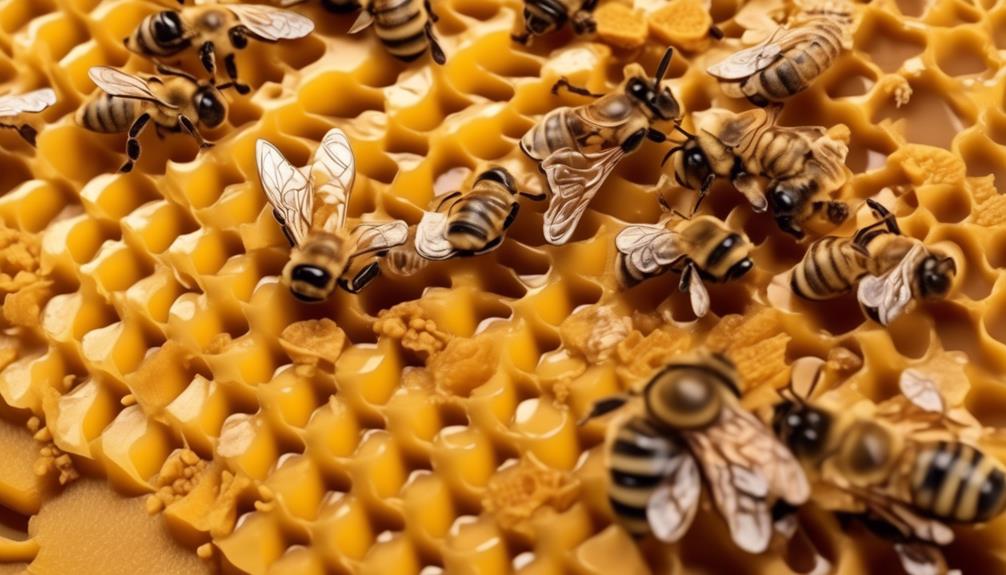
Now, let's delve into the core components that make up beeswax, unraveling the intricate blend of compounds in this natural marvel. Comprising mainly esters, fatty acids, and long-chain alcohols, beeswax holds a complexity that's as fascinating as it's functional.
The majority of beeswax, about 70%, is made up of esters. These are formed when an alcohol and a fatty acid react in a process known as esterification. The specific esters in beeswax are primarily myricyl palmitate, cerotic acid, and melissyl alcohol.
The fatty acids in beeswax account for about 14% of its composition. These are usually long-chain compounds, with palmitic, oleic, and linoleic acids being the most common. They contribute to the hardness and melting point of the wax.
Lastly, you'll find hydrocarbons and trace elements, including vitamins, pollen, and propolis. These make up the remaining 16% and add to the overall complexity and functional properties of beeswax. They're also responsible for the characteristic color and odor of beeswax.
Beeswax Uses and Benefits
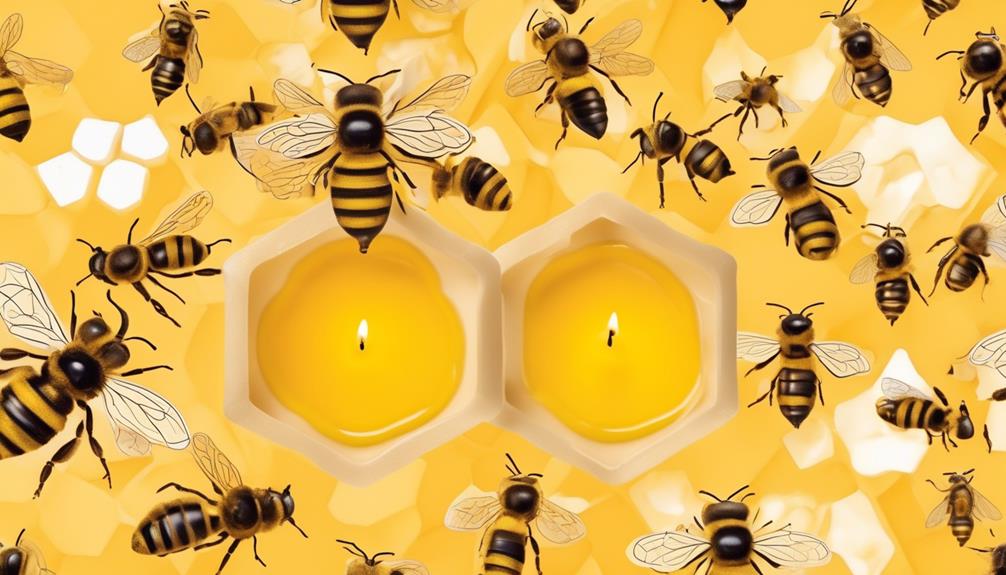
Beyond its intricate chemistry, beeswax shines in various applications, offering numerous benefits due to its unique properties. It's used extensively in cosmetics because of its emollient, soothing, and softening properties that help the skin retain moisture. Its rich vitamin A content promotes cell reconstruction and health.
In the field of medicine, beeswax has been utilized for its healing properties. It's known to have antibacterial properties, making it useful in treating minor skin irritations. It's also used as a coating for pills and supplements as it's non-toxic and doesn't interfere with the medication's effectiveness.
In the home, beeswax is a popular ingredient in candles due to its slow and smokeless burn. It also purifies the air by releasing negative ions, helping to neutralize pollutants.
In the food industry, it's used as a coating for cheese to prevent moisture loss and keep it fresh. Additionally, beeswax can be used as a food wrap, serving as a sustainable alternative to plastic.
Its remarkable versatility, coupled with its natural origin, makes beeswax a highly sought-after commodity. Whether in cosmetics, medicine, home goods, or food, you'll find beeswax's unique properties hard to replace.
Sustainability and Beeswax Production
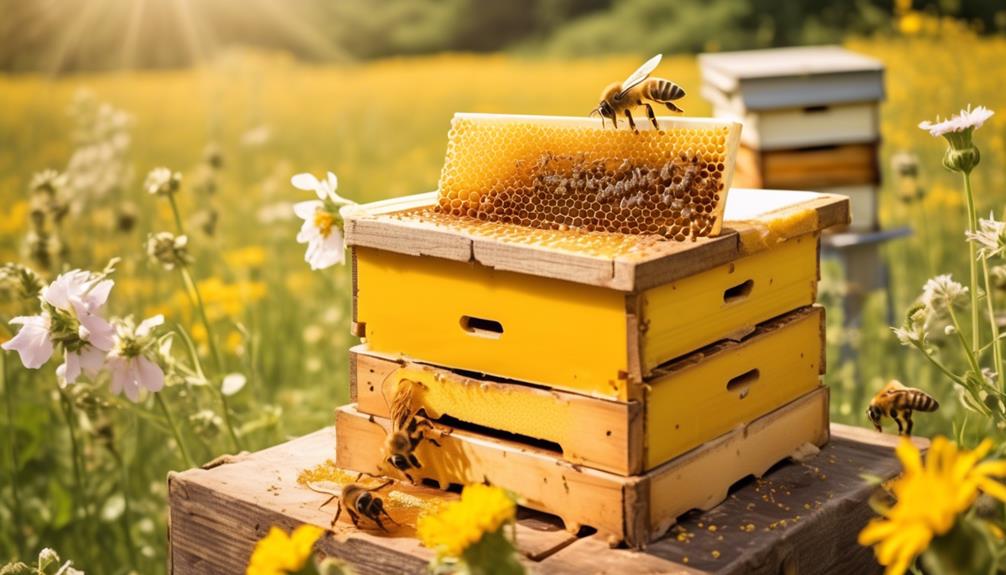
While the myriad uses of beeswax highlight its importance, it's equally critical to understand the sustainable practices employed in its production. Beeswax production is intrinsically sustainable, being a natural by-product of honeybees who manufacture it to build their honeycombs.
As bees gather nectar for honey, they secrete wax from their abdominal glands. Once harvested, this beeswax can be purified and used without causing harm or distress to the bee colonies. It's a cyclical and renewable process, with bees constantly producing beeswax for their hives. Unlike synthetic substitutes, beeswax doesn't require intensive resource inputs or cause environmental pollution during its production.
However, sustainable beeswax production also relies on bee-friendly practices. Over-harvesting of beeswax or honey, use of pesticides, and habitat destruction can disrupt bee populations and their wax production.
You, as a consumer, can promote sustainable beeswax production by choosing products from organic, pesticide-free beekeeping operations. By doing so, you're not just supporting a sustainable industry but also contributing to bee conservation efforts.
Frequently Asked Questions
What Are Some Common Allergies Associated With Beeswax?
You might experience allergies to beeswax if you're sensitive to honey or bee pollen. Common reactions include skin irritation, rashes, or even breathing problems.
It's also possible to have an allergic reaction to residues of pesticides or antibiotics that might be in the beeswax.
It's always a good idea to test a small amount of any product containing beeswax on your skin before using it extensively.
Can Beeswax Be Used in a Vegan Lifestyle?
No, you can't use beeswax in a vegan lifestyle. It's produced by bees, which are animals. Vegans avoid all animal products, not just meat and dairy.
Beeswax is often found in candles, cosmetics, and food, so you'll need to find vegan alternatives for these items. There are many plant-based waxes, like soy or candelilla, that can be used instead.
Always check product labels to ensure they align with your lifestyle.
Are There Any Potential Health Risks of Using Products Made From Beeswax?
You're asking if there are health risks associated with beeswax products. Generally, these products are safe for most people.
However, if you're allergic to honey or bee pollen, you may have a reaction to beeswax as well. Symptoms could include skin irritation or respiratory issues.
Always do a patch test before using a new product.
Pregnant or breastfeeding women should consult a doctor before using beeswax products.
How Does the Production of Beeswax Impact the Bee Population?
You're curious about beeswax and its impact on bee populations.
It's quite fascinating, really. Bees aren't harmed during beeswax production. They naturally secrete wax to build their honeycombs.
When beekeepers extract honey, they scrape off this wax cap, melting it down into beeswax.
The process can actually support bee populations, as responsible beekeeping encourages a healthy, thriving environment for these vital pollinators.
What Are Some Lesser-Known Industries or Products That Utilize Beeswax?
You'd be surprised at the variety of industries that utilize beeswax.
It's found in cosmetics like lip balm and lotion, giving them a smooth texture.
In the food industry, it's used as a coating for cheese to preserve freshness.
Even the candle industry relies on beeswax for its clean-burning properties.
Beyond that, beeswax is used in the pharmaceutical industry for tablet coatings and in the automotive industry for car wax.
Conclusion
In essence, beeswax is a miraculous product of nature, conjured up by worker bees from their own bodies. Composed of esters, fatty acids and long-chain alcohols, it boasts an array of uses from cosmetics to candle making.
Its sustainability makes it an eco-friendly choice. Understanding its production and components truly highlights the genius of nature and the incredible hard work of our buzzing friends.
So, next time you see a bee, show some respect for these little wax factories.

